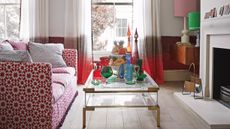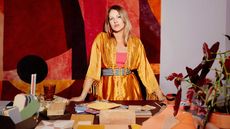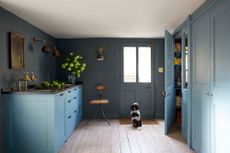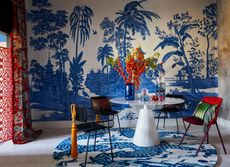Emily Johnson on the magic of ceramics

But by her own admission, if you’d told her 20 years ago she’d go on to set up the design-led ceramics brand 1882 Ltd in 2011 (in partnership with her dad Chris, a Stoke pottery veteran), she would have said ‘no way’.
‘I spent a lot of time with him in the factory,’ Emily says of the year she was working for Wedgwood until his retirement in 2002, following the company’s purchase of Johnson Brothers in the Sixties, ‘but there was never a pull to go into the family business’. Instead, she travelled before arriving in LA and working in TV advertising.

It wasn’t until she returned to the UK in 2008 and enrolled in a master’s degree in architectural interior design at London’s Inchbald School of Design that the ‘magic of ceramics’ sucked her back in.‘ We were asked to explore a material in more detail and I chose bone china,’ she says of creating a collection of tube-like lights, which she naturally called on her dad for help with.
Immediately she appreciated better the ‘beautiful translucency’ of bone china, a material first developed by Josiah Spode in the early 1790s in lieu of access to clay-based porcelain.‘It’s strong, too,’Emily enthuses. ‘One of my party tricks is to stand on a teacup turned upside down to prove it won’t break.’

In 2011, Emily founded 1882 Ltd and a year later she debuted during London Design Festival with Max Lamb’s Crockery jugs, mugs and bowls, modelled from the designer’s own chunky, organic shapes hand-carved in plaster.
Innovation has always been core: the shape and texture of Philippe Malouin’s Dunes plates and bowls modelled on 3D-modelled piles of sugar; John Pawson’s Cast bowl – ‘a feat of engineering because the support helping it hold its shape while firing was as complicated to make as the bowl itself,’ says Emily.
She has created collections with furniture designers Pinch and Faye Toogood, artists Bruce McLean, Barnaby Barford and Grayson Perry, and fashion design duo Peter Pilotto, whose painterly, swirly floral plates are inspired by one of their fabric designs.

At this year’s Salone del Mobile, she launched Stack with fashion designer Sir Paul Smith, a limited- edition collection of vases that ‘play a visual trick with a stack of plates turned into a vessel’, she enthuses.‘The first one we made looked like the Leaning Tower of Pisa but miraculously it readjusted itself in the kiln.’

During September’s London Design Festival, Emily added new pieces to Lustre, the 22-carat gold and black reinterpretation of designer Bethan Gray’s Dhow pattern, and debuted hand-painted pieces by Martyn Thompson, a former fashion and interiors photographer turned designer, at a pop-up held in Jo Malone London’s townhouse HQ.
She has also created the vessels for Martyn’s candles and fragrance diffusers with the brand, due out in April.

See more collections from Bethan Gray.
With no two collections the same – each piece is largely handmade so even a simple mug goes through at least 11 sets of hands during production – 1882 Ltd’s aesthetic brings an imaginative edge to ‘everyday pieces, made well’, says Emily.

It will continue to champion the skills of Stoke’s talented craftspeople for generations to come. ‘To me, Stoke stands for the best heritage industrial craft skills in the country, if not the world.'
1882ltd.com
See more of our favourite designers.
Be The First To Know
The Livingetc newsletter is your shortcut to the now and the next in home design. Subscribe today to receive a stunning free 200-page book of the best homes from around the world.
Jacky Parker is a London-based freelance journalist and content creator, specialising in interiors, travel and food. From buying guides and real home case studies to shopping and news pages, she produces a wide range of features for national magazines and SEO content for websites
A long-time contributor to Livingetc, as a member of the team, she regularly reports on the latest trends, speaking to experts and discovering the latest tips. Jacky has also written for other publications such as Homes and Gardens, Ideal Home, Red, Grand Designs, Sunday Times Style and AD, Country Homes and Interiors and ELLE Decoration.
-
 The 12 Best Table Lamps for Reading —I'm a Certified Bookworm (and Shopping Expert)
The 12 Best Table Lamps for Reading —I'm a Certified Bookworm (and Shopping Expert)When it comes to table lamps for reading, I don't mess around. If you're the same, this edit is for YOU (and your books, or course — and good recommendations?)
By Brigid Kennedy Published
-
 "It's Scandi Meets Californian-Cool" — The New Anthro Collab With Katie Hodges Hits Just the Right Style Note
"It's Scandi Meets Californian-Cool" — The New Anthro Collab With Katie Hodges Hits Just the Right Style NoteThe LA-based interior designer merges coastal cool with Scandinavian simplicity for a delightfully lived-in collection of elevated home furnishings
By Julia Demer Published
-
 Florist Angela Maynard on how to care for dried flowers and how to style them in a modern home
Florist Angela Maynard on how to care for dried flowers and how to style them in a modern homeKnowing how to care for dried flowers means you can have stylish arrangements that last for years. Author and florist Angela Maynard shares her tips
By Angela Maynard Last updated
-
 11 beige living room ideas that prove beige can be far from boring
11 beige living room ideas that prove beige can be far from boringBeige living room ideas might sound not sound like the boldest of color schemes but this pared-back palette can be just as striking a brights
By Amy Moorea Wong Last updated
-
 How to use color in small living rooms – expert tips for getting the perfect scheme
How to use color in small living rooms – expert tips for getting the perfect schemeBringing color into small living rooms can be tricky, but with the right hues and our top tips, you can make the space look brighter, bigger and just better
By katesleeman Published
-
 How to choose cool colour combinations for your home
How to choose cool colour combinations for your homeThe right colour combinations will look good throughout your home. Dagny Thurmann-Moe of Koi Colour Studio shares the no-go palette pairings and power hues
By Livingetc Published
-
 Buying a used kitchen could be your savviest design idea - here's what you need to know
Buying a used kitchen could be your savviest design idea - here's what you need to knowBuying an ex-display used kitchen is a way to a high-end home at High Street prices
By Jacky Parker Published
-
 Home decorating: Tricia Guild's guide to a confident scheme
Home decorating: Tricia Guild's guide to a confident schemeHome decorating advice from legendary designer Tricia Guild OBE
By Livingetc Published
-
 How to achieve beautiful paint finishes according to interior designer, Nicola Harding
How to achieve beautiful paint finishes according to interior designer, Nicola HardingBeautiful paint finishes transform a room and are easier than you think
By Livingetc Last updated
-
 The meaning of style, by interior designer Russell Sage
The meaning of style, by interior designer Russell SageAcclaimed interior designer Russell Sage talks broken rules, secret ingredients and looking good in any light
By Russell Sage Published









